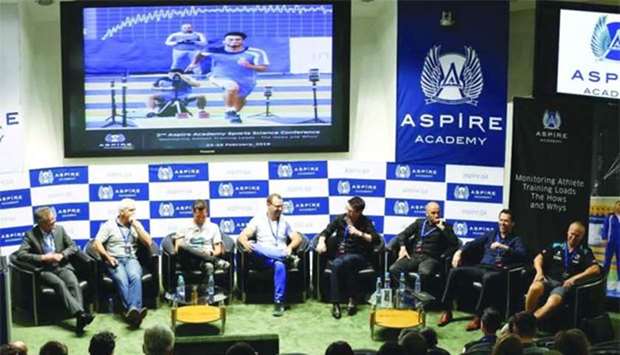An article published in the International Journal of Sports Physiology and Performance in 2017, titled ‘Monitoring Athlete Training Loads: Consensus Statement’ and compiled by Aspire Academy’s sports science experts, reached more than 11,000 downloads worldwide and over 100 citations, making it the most downloaded research paper during the journal’s 18 years in business.
This has been announced by Aspire Academy in a press statement.
“With this achievement, Aspire Academy adds another testament to its leading role as a sports institution. Utilising its expertise and bringing together the world’s best minds to make positive contributions to the world of sports science, Aspire Academy constantly pushes towards Aspire Zone Foundation’s (its parent organisation) vision of becoming a reference in sports excellence by 2020,” the statement noted.
Athletes performing at a professional level need to train regularly and consistently without overexerting themselves, which increases the risk of injury. But there’s a very fine line between adequate training and work overload. If a player trains too much, they risk injury. If they don’t train enough, they won’t have the physiological development to support their performance when they compete.
Coaches and scientists around the world have attempted to the draw this line. One approach focuses on monitoring players’ internal and external training load. Internal load can be measured by observing the physiological symptoms of work overload, such as heart rate. External workload factors include distance travelled, speed, time and power volume, among others.

Tim Cable
Because literature on the topic is so vast and different experts have developed different measurement tools and methods, Aspire Academy sought to bring together the world’s leading minds in one place in the Academy’s second Training Load 2016 Conference.
The conference, which brought together more than 20 international speakers and 250 delegates, yielded many positive insights that later generated 23 research papers, all of which have been downloaded and cited in significant numbers by sports scientists everywhere.
The ‘Monitoring Athlete Training Loads: Consensus Statement’ was among them. Since its publication, the research paper has become an important guide used by some of the best sports scientists working with the world’s top elite athletes across various sports.
Speaking about the importance of the paper, Tim Cable, one of the paper’s authors and director of Sports Science at Aspire Academy, said: “Because measuring training load can be a complex task, this paper is a very useful tool for our profession. It enables optimum training adaptation whilst ensuring the health and wellbeing of athletes. It’s an approach we already implement at Aspire Academy when we plan the training schedules for our student-athletes.
“In the world of football, for example, we are dealing with players that are worth hundreds of millions of pounds. If they’re out for months, that’s a significant loss of money. So (coaches) have to reduce the risk of injury by developing training schedules that do not overwork their athletes. There might be variation in terms of how to measure workload from one sport to another, but, generally, this consensus statement provides a good rule of thumb for any professional.”
Aspire Academy student-athletes are developed through a comprehensive athlete portfolio management process, whereby coaches, educators, support staff, service providers and management personnel actively co-operate to create an integrated Long-Term Athlete Development programme based on specific and measurable performance outcomes. Progressive development, rigorous adherence to duty-of-care and a fun and interactive learning environment are all core to these efforts.
“With this achievement, Aspire Academy adds another testament to its leading role as a sports institution. Utilising its expertise and bringing together the world’s best minds to make positive contributions to the world of sports science, Aspire Academy constantly pushes towards Aspire Zone Foundation’s (its parent organisation) vision of becoming a reference in sports excellence by 2020,” the statement noted.
Athletes performing at a professional level need to train regularly and consistently without overexerting themselves, which increases the risk of injury. But there’s a very fine line between adequate training and work overload. If a player trains too much, they risk injury. If they don’t train enough, they won’t have the physiological development to support their performance when they compete.
Coaches and scientists around the world have attempted to the draw this line. One approach focuses on monitoring players’ internal and external training load. Internal load can be measured by observing the physiological symptoms of work overload, such as heart rate. External workload factors include distance travelled, speed, time and power volume, among others.

Tim Cable
Because literature on the topic is so vast and different experts have developed different measurement tools and methods, Aspire Academy sought to bring together the world’s leading minds in one place in the Academy’s second Training Load 2016 Conference.
The conference, which brought together more than 20 international speakers and 250 delegates, yielded many positive insights that later generated 23 research papers, all of which have been downloaded and cited in significant numbers by sports scientists everywhere.
The ‘Monitoring Athlete Training Loads: Consensus Statement’ was among them. Since its publication, the research paper has become an important guide used by some of the best sports scientists working with the world’s top elite athletes across various sports.
Speaking about the importance of the paper, Tim Cable, one of the paper’s authors and director of Sports Science at Aspire Academy, said: “Because measuring training load can be a complex task, this paper is a very useful tool for our profession. It enables optimum training adaptation whilst ensuring the health and wellbeing of athletes. It’s an approach we already implement at Aspire Academy when we plan the training schedules for our student-athletes.
“In the world of football, for example, we are dealing with players that are worth hundreds of millions of pounds. If they’re out for months, that’s a significant loss of money. So (coaches) have to reduce the risk of injury by developing training schedules that do not overwork their athletes. There might be variation in terms of how to measure workload from one sport to another, but, generally, this consensus statement provides a good rule of thumb for any professional.”
Aspire Academy student-athletes are developed through a comprehensive athlete portfolio management process, whereby coaches, educators, support staff, service providers and management personnel actively co-operate to create an integrated Long-Term Athlete Development programme based on specific and measurable performance outcomes. Progressive development, rigorous adherence to duty-of-care and a fun and interactive learning environment are all core to these efforts.



